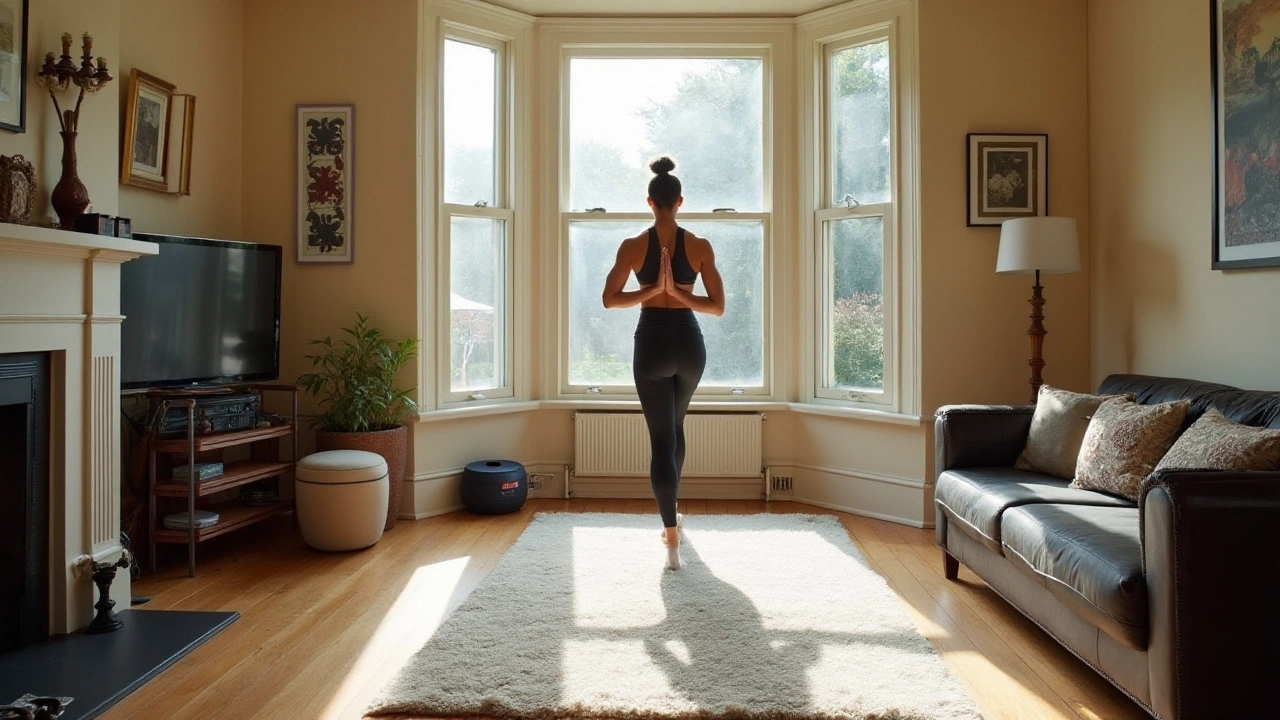
With the rise of home workouts, many fitness enthusiasts find themselves wondering about the pros and cons of daily exercise. Is it beneficial to break a sweat every day, or does your body need rest to thrive? This query is more common now as living rooms double as gyms and dining chairs become bicycle crunch stations.
Engaging in daily workouts has its undeniable perks. It not only keeps you in shape but also boosts your mood and overall energy levels. However, a critical balance must be struck to avoid burnout or injury. Understanding your body's needs and limitations plays a crucial role in forming an effective habit.
This article will delve into the nuances of exercising daily at home, highlighting the benefits and pointing out the potential downfalls. We'll discuss strategies to tailor your workouts, ensuring they are both safe and rewarding. Join us in unraveling the truth behind daily home workouts, and find a routine that suits you best.
- Understanding Daily Exercise
- Benefits of Home Workouts
- Potential Risks and Considerations
- Creating a Balanced Routine
- Listening to Your Body
Understanding Daily Exercise
When you think about daily exercise, the image that often comes to mind might be of Olympic athletes or fitness buffs with an ironclad commitment to their routines. But for the average person, exercising every day doesn't have to equate to hours of intense, sweat-dripping activity. It's about finding movement that keeps your body happy, resilient, and strong. Embracing a daily exercise can mean different things – from a gentle morning yoga session to a brisk evening walk, or a heart-pumping cardio routine in your living room. Understanding what your body needs requires a little bit of insight into how various types of exercises affect our well-being.
In reality, a well-rounded exercise program typically includes a mix of cardiovascular work, strength training, flexibility exercises, and balance-enhancing activities. Cardiovascular exercises, like jogging or cycling, help maintain a healthy heart rate and lung function. Strength training, which might involve weights or resistance bands, fortifies the muscular and skeletal systems, which can fend off age-related decline. Flexibility and balance exercises improve your range of motion and stability, which play vital roles in preventing injuries. So, when we talk about daily workout routines, it's crucial to incorporate these various elements to achieve holistic fitness.
The Centers for Disease Control and Prevention (CDC) recommends that adults aim for at least 150 minutes of moderate-intensity aerobic activity, such as brisk walking, each week, along with muscle-strengthening activities on two or more days a week. This provides a baseline for understanding how daily activity can be beneficial. However, if you're targeting specific fitness goals, like hypertrophy or endurance, your plan might differ. Variety in your home workout schedule ensures that you get a full-body workout without the risk of overuse injuries.
"Physical fitness is not only one of the most important keys to a healthy body; it is the basis of dynamic and creative intellectual activity," said John F. Kennedy, a firm believer in the power of regular movement.
For some, daily exercises can transform into a form of meditation, a habitual part of daily life, tapping into mental and emotional well-being. It's about recognizing the seamless blend of mental calmness with physical exertion. Studies have shown that regular exercise releases endorphins, the body's natural mood lifters, reducing stress and anxiety levels. Exercising daily thus holds the power to transform not just your body but also your mind.
Yet, while daily exercise can bring numerous benefits, it's essential to listen to one’s body. Each person is unique; what works for one may not necessarily suit the other. Paying attention to signs of fatigue, burnout, or injury is key. In tailoring home workout plans, flexibility is crucial, allowing for rest days when needed, gently easing on certain target areas, and maintaining motivational levels high. This approach ensures that exercise remains an enjoyable, sustainable part of your routine, not a monotonous chore. Thus, understanding daily exercise is not just about the physical act but about connecting with oneself, adopting discipline, and achieving balance.
Benefits of Home Workouts
Embarking on a home workout routine brings a fountain of benefits that extend beyond simple physical improvement. During these hectic times, working out at home offers unparalleled convenience. There's no need to worry about gym hours or travel time. Working out can seamlessly fit into any part of your day, whether you're an early bird who exercises with the sunrise or a night owl stretching before bed. This flexibility ensures that even the busiest schedules can accommodate a workout session, bypassing any excuse about lack of time.
The financial aspect of home workouts is another significant advantage. While gym memberships or boutique fitness classes can put quite a dent in your wallet, exercising at home costs little to nothing. Whether you're streaming a free yoga class or doing a bodyweight circuit in your living room, the expenses remain minimal, making fitness accessible to all. Investing in basic equipment like resistance bands or dumbbells can enhance your workout without breaking the bank.
According to an article in the Journal of Physical Activity and Health, those who were physically active at home were significantly happier and reported better quality of life.
The psychological benefits cannot be overstated. Engaging in regular exercise from the comfort of home can lead to improved mental health, serving as a reliable stress reliever. The familiarity of the home setting can create a relaxed atmosphere where one can focus solely on the joy of movement. Furthermore, exercising at home removes any intimidation factor some might experience in public gyms, fostering an environment where self-improvement takes precedence over comparison or judgment.
From a consistency standpoint, sticking to a fitness routine becomes significantly easier when the gym is just a room away. This accessibility can foster a habit of daily exercise, aiding in maintaining a sustainable fitness journey. For families, home workouts present opportunities to include every household member, promoting a healthy lifestyle as a family activity. Seeing mom, dad, or siblings exercise might inspire children to be more active, laying the foundation for lifelong healthy habits.
Lastly, home workouts allow for endless variety catering to personal preferences, making exercising enjoyable rather than a chore. Whether it's practicing Pilates in the kitchen, sweating it out to a HIIT program in the backyard, or simply dancing to music in the living room, the variety prevents monotony. This ability to switch up your routine at a whim keeps motivation alive and offers your body new challenges continually. So, whether it's raining, snowing, or a sweltering 100 degrees outside, your workout never gets canceled.

Potential Risks and Considerations
As beneficial as daily home workouts can be, they come with their share of risks and challenges. Consistency in fitness is crucial, yet ignoring the body's pleas for rest may lead to harmful consequences. A key concern is overtraining, which occurs when the intensity and frequency of exercise exceed the body’s ability to recover. Recognizing the signs of overtraining like persistent fatigue, decreased performance, and mood changes can help in mitigating these risks. Even the most resilient fitness enthusiasts must intersperse their routines with rest days.
Another consideration is the risk of injury from performing exercises with improper form due to inadequate supervision at home. Home workouts often mean learning new exercises from videos or apps without professional guidance. Although digital platforms provide valuable training tips, they may not offer personalized feedback, which increases the chance of performing exercises incorrectly. This can lead to sprains, strains, or more severe injuries, taking away from any progress made.
Balancing Variety and Focus
Diversifying exercise routines is both a strategy to keep workouts engaging and a method for injury avoidance. Repetitive movements without enough variation can overwork specific muscle groups while underutilizing others. For instance, focusing solely on cardiovascular workouts may neglect muscle building, while an overemphasis on strength training could ignore cardiovascular health. Achieving a balanced approach demands a thoughtful mix of activities such as yoga, strength training, and aerobic exercises. The mix keeps body fatigue at bay and enhances overall fitness.
"The importance of rest days cannot be overstated," says Dr. Emily Parker, a renowned sports physician, "They allow muscles to repair, rebuild, and strengthen. Overtraining without adequate rest is akin to trying to fill a cup that already overflows."
Psychological Aspects
Maintaining daily exercise routines at home can also affect psychological well-being. Physical activity is a known mood booster, releasing endorphins that provide a natural high. Yet, when exercise becomes an all-consuming part of your life, it can create stress and feelings of burnout. The fine line between commitment and compulsion must be navigated carefully. Listening to one’s mental health signals is just as vital as understanding physical indicators. A mindful approach to fitness that embraces flexibility can help maintain both motivation and enthusiasm.
An additional point of consideration is the nutrition needed to sustain daily workouts, especially at home where access to resources might be limited compared to a gym's setting. Individuals must ensure they consume a balanced diet that provides sufficient energy and nutrients to support their regular routines. Hydration is often overlooked but plays a critical role in maintaining performance and recovery. Hence, a focus on comprehensive well-being, including nutritional and mental health support, goes hand in hand with consistent workouts.
Creating a Balanced Routine
Designing a balanced routine is crucial for anyone diving into the realm of home workouts. The term 'balance' often conjures up images of physical poise, yet in fitness, it means something quite different. To craft a routine that serves your body well, you need to blend a mix of exercise types while pacing yourself appropriately. It's not just about what you do but how you do it – integrating strength, flexibility, and cardiovascular activities can make all the difference in achieving a holistic approach to fitness. Studies have shown that diversifying workouts can keep your body engaged and your mind fresh, reducing the likelihood of monotony that often leads to a waning commitment. By incorporating a bit of everything, you ensure that no single muscle group is overworked or underutilized.
As Jane Fonda, a well-respected fitness influencer, once said, "It's not about being perfect. It's about effort. And when you implement that effort into your life... every single day, that's where transformation happens.”
The journey to creating a sustainable fitness regimen begins with understanding the various types of exercises and their unique benefits. Cardio exercises, for instance, elevate your heart rate and improve overall endurance, while strength training reinforces muscle and bone health. Flexibility exercises aid in enhancing range of motion and reduce the chances of injury. When these elements are combined creatively, they forge a routine that amplifies your physical capabilities and boosts mental well-being. It's interesting to note that people who engage in a variety of workout types are often more enthusiastic about their practice because variety keeps things exciting and challenging, encouraging adherence.
Setting Your Workout Schedule
Establishing a consistent yet flexible schedule helps in forming a habit that feels less of a chore and more of an enjoyable ritual. It's recommended to schedule workouts at times when your energy levels peak, be it an early morning session to kickstart your day or an evening workout to unwind. Consistency is key, yet it's equally important to be forgiving with oneself if tweaks are needed occasionally. Assess and adapt your routine by mixing different types of workouts across the week. For example, you could kick off Monday with a high-energy cardio session, follow up on Tuesday with strength training targeting the upper body, and perhaps set aside Wednesday for a gentle yoga class to stretch and relax those worked muscles. Tailoring your week based on goals, fitness levels, or even whims ensures you stay engaged.
Cross-training can be incredibly beneficial; it not only improves overall fitness but also reduces the risk of overuse injuries. Speaking of numbers, a well-crafted weekly plan might look something like this: three days of cardio exercises such as running or cycling, two days dedicated to strength training focusing on different muscle groups, and two days of yoga or pilates to work on flexibility and core strength. You might also consider integrating rest or active recovery days, which can be just as vital as workout days. Active recovery could entail a leisurely walk with your dog, like Artemis, or a relaxing stretching session alongside your cat, Nimbus, providing a delightful combination of activity and relaxation.
Home workout enthusiasts should ensure they have the right equipment on hand to aid in their workouts. While it isn't necessary to invest heavily, having essentials like a yoga mat, resistance bands, and dumbbells can enrich your routine significantly. That said, the most essential tool is perhaps a desire to move and improve. By taking time to craft a balanced workout regimen and adjusting it with your progress, you’re laying a robust foundation for lasting health. Remember, the perfect routine is not one fit for everybody but one tailor-made by and for you. Embrace the journey, even when the path is unpaved and unpredictable.

Listening to Your Body
In the world of daily home workouts, developing a keen ear for your body's signals stands as one of the most essential skills. As you embark on this fitness journey, tuning into your senses can be the key to achieving a healthy balance between fitness gains and over-exertion risks. Whether you're pushing through a challenging yoga flow or breaking a sweat with a high-intensity interval session, knowing when to rest and when to push can transform your routine.
The body speaks in a language of its own, often disseminating messages through feelings of fatigue, soreness, or discomfort. It's crucial to differentiate between the mild soreness that accompanies an effective workout and the sharp, persistent pain that may signal the need for a rest day or even medical attention. Remember that while some level of discomfort is expected, ignoring signs of strain can lead to burnout or even long-term injuries.
Learning to read these signs doesn’t mean you must skip your fitness routines entirely. Sometimes simply modifying exercises, reducing intensity, or focusing on different muscle groups can help maintain your routine while providing the necessary rest for parts of your body under stress. Incorporate a mix of strength, cardio, and flexibility workouts to give your muscles and joints a well-rounded experience. This strategy can help prevent overuse injuries by offering balanced muscle engagement.
Adding variety is also crucial to keeping your workouts enjoyable. Stick to a plan that includes both intense and light exercise days. This varied approach not only helps in avoiding monotony but also allows athletes at all levels, from beginners to seasoned exercisers, to reap maximum benefits while respecting their body's needs. Light activities like stretching or easy walks serve an essential purpose on active recovery days, aiding in muscle recovery without overwhelming the body.
"Rest is not idleness, and to lie sometimes on the grass under trees on a summer's day, listening to the murmur of water, or watching the clouds float across the sky, is by no means a waste of time." — John Lubbock
Indeed, listening to your body is not just about avoiding negative outcomes; it opens the door to understanding what truly energizes and invigorates you. As you become attuned to how different activities affect your mood and energy levels, it guides you in creating a tailor-made routine that fosters both physical and mental wellness. Recognizing the intricate mind-body connection can elevate your workouts from a mere physical pursuit to a practice that deeply nurtures your entire being.
